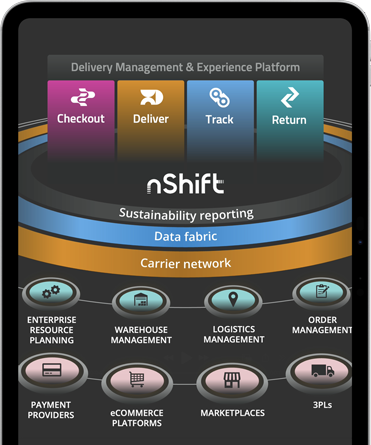Content library
Solve your delivery challenges,
one key insight at a time
Browse expert guides tackling checkout, returns, carrier strategy, and more.
2026 Trends report
The future of delivery:
Delivery & logistics trends shaping 2026
Top ten interconnected trends reshaping delivery across the EU and the UK, from AI and platforms to regulation, resilience, and retail demand.

See nShift in action

Try our demo store
Real stories, real results
To protect margin on oversized furniture to Germany, without compromising customer experience, Granit replaced a previous link-based checkout with nShift’s new Checkout.
By implementing nShift Delivery and Checkout, Rebelz has streamlined fulfilment workflows and offered a smooth and convenient checkout experience.
Sweden Buyers Club uses nShift to connect checkout, delivery and tracking into one scalable logistics backbone as order volumes and product diversity grow.
With nShift Ship integrated into its AutoStore-powered warehouse, Imerco can now handle seasonal spikes smoothly and has increased annual shipments by 14%.
By connecting checkout, warehouse and carriers through nShift, VITA now offers 30-minute in-store pickup and next-day delivery across much of Norway.
Thanks to nShift, Stenströms now ships efficiently to customers worldwide with less manual work and fewer delays. The company’s logistics team has the tools to manage growing volumes while continuing to deliver on the brand’s promise of quality and service.
GLOWiD reduced delivery errors by 50%, cut order processing time from three minutes to 30 seconds and saved 1.5 full-time employees annually with nShift.
With nShift, Millesima is simplifying carrier onboarding, strengthening its carrier network and giving customers more visibility on high-value orders.
By consolidating multiple processes into one platform, Laithwaites can now offer customers greater transparency, flexibility, and control over deliveries.
Hunkemöller, Europe’s fastest-growing lingerie retailer, replaced printed return labels with a fully digital returns experience using nShift Returns.
By implementing nShift Track, ICANIWILL gained full control of delivery notifications and tracking pages, transforming them into engaging touchpoints.
How expanding pickup point delivery (PUDO) options through nShift Checkout helped Flying Tiger Copenhagen achieve a 20% increase in conversions.





























